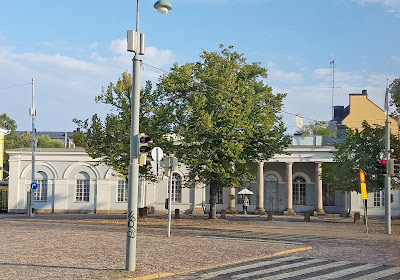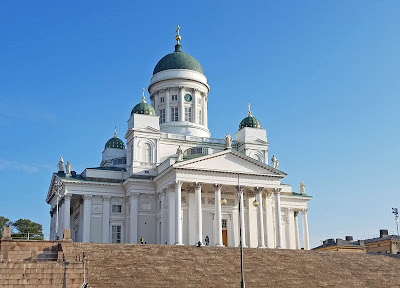Thursday, September 6, 2018
The Viking Star now heads west in the Baltic Sea, and we arrive in Helsinki, Finland.
 |
| View from the stateroom |
 |
| Below us are a couple painted seal lions (they have ear flaps) |
For once, our included shore excursion, which is generally an introduction or orientation to a city/town, is the first thing scheduled in the day: Glimpse of Helsinki. Started on a motor coach because the dock is a couple miles from the city center.
 |
| Permitted street art in the port |
 |
| Helsingin telakalta/Helsinki Shipyard now used to build icebreaker ships |
 |
Helsingin ortodoksinen hautausmaa/Helsinki Orthodox Cemetery (1815)
with the double bar white Orthodox crosses |
 |
Hietaniemen vanha kappeli/Hietaniemi Old Chapel
(1872, by Theodor Höijer) |
 |
Hietaniemen uimaranta/beach; apparently all beaches
have a sauna, so that the Finns can get really hot, then
run out and jump in cooler waters (of Seurasaari Bay) |
 |
Mattolaituri/Carpet pier where every summer the Finns bring their rugs
to scrub in sea water, wring out in a mangle, and dry on wooden racks |
A photo stop at the Sibelius Monument.
 |
Sibelius-monumentti/Sibelius Monument with Passio Musicae/Love of Music
(1967, by Eila Hiltunen), to the Finnish composer, Jean Sibelius |
 |
The artist was required to add a bust of Sibelius;
Fernando & Josefina in the act of a selfie! (KSS) |
 |
| Our attempt at a selfie! |
 |
| There are over 600 pipes in the sculpture |
 |
Uusi lastensairaala/New Children's Hospital (2015-2018,
by SARC Architects) will open later in September 2018 |
 |
Oh! The Ratikkamuseo/Helsinki Tram Museum(1993) in a
former tram barn (1900, by Valdemar Aspelin) |
 |
| The current raitiovaunuvarikko/tram barn |
 |
Olympiastadionin tornin/Olympic Stadium Tower
is rumored to be 72.71 m/239' tall, the distance that
Finn Matti Järvinen threw the javelin to win
the gold medal at the 1932 Olympics |
 |
Helsingin olympiastadion/Helsinki Olympic Stadium (1934-1938,
by Yrjö Lindegren and Toivo Jäntti) is under reconstruction |
The Olympic Stadium was built for the 1940 Summer Olympics, which was cancelled at the outbreak of World War II. Helsinki eventually hosted the 1952 Summer Olympics.
 |
Statue (1952, one of five cast by Wäinö Aaltonen)
of Paavo Nurmi, nicknamed the "Flying Finn,"
was a middle- and long-distance runner and winner
of nine gold and three silver medals at the
1920, 1924, and 1928 Summer Olympics |
We passed so many landmarks, but views from the bus were blocked by trees, especially of
Finlandiatalo/Finlandia Hall (1967-1971), the concert hall designed by Alvar Aalto. Aalto's works are mainly in Europe, but in the United States he designed the Finnish Pavilion at the 1939 New York World's Fair and the Baker House (dormitory) at Massachusetts Institute of Technology in Boston.
 |
Musiikkitalo/Music Center (2006-2011, by Arkkitehtitoimisto LPR-Arkkitehdit
and Yasuhisa Toyota for acoustics), which is 2/3 underground |
 |
Svenska Teatern/Swedish Theater (renovated 1935, by
Eero Saarinen and Jarl Eklund in Functionalism style), was initially
built for the Swedish population during the time of Russian rule |
Finland has two official languages, Finnish and Swedish. Finland was under Swedish rule from the 13C until 1809, when the Russian Empire took over.
 |
Main Guard Post Building (1843, by Carl Ludvig Engel)
houses the Presidential Guard, who were pretty busy a couple months
ago when Finland hosted Trump and Putin |
 |
Säätytalo/House of Estates (1888-1891, by
Karl Gustav Nyström in Neo-Renaissance style) for
three of the four estates of the realm (clergy, burghers,
and land-owners) that could send representatives
to the governing body of the time; now
a government banqueting venue |
 |
Ritarihuone/House of Nobility (1857-1862, by Georg Chiewitz
in Neo-Gothic style) was for the fourth estate of the realm |
The motor coach dropped us off in
Senaatintori/Senate Square (1816-1840, by Carl Ludvig Engel in Neo-Classical style). When Russia conquered Finland, Tsar Alexander II proclaimed it an autonomous Grand Duchy and decided to create its capital in Helsinki. Carl Ludvig Engel was appointed the architect for reconstruction and it became his life-long task.
 |
Sederholmin Talo/Sederholm House (1757), the oldest
stone building in Helsinki, is in the SE corner of the square |
 |
On the east side of the square is the Oikeuskanslerin Virasto/
Government Chancellery (1822, as the Senate Building) |
 |
On the opposite side is the Helsingin yliopiston päärakennus/
University of Helsinki Main Building (1832) |
 |
Kansalliskirjasto/The National Library of Finland (1840-1845
as the University Library) is in the NW corner of the square |
 |
Dominating the square up a grand stairway is the
Helsingin tuomiokirkko/Helsinki Cathedral (1830-1852) |
(I was in
Helsinki in 1982 on a Scandinavian Eurail trip.)
 |
| Helsinki Cathedral (7/20/1982) |
 |
In the center of the square is a statue (1894, by
Walter Runeberg) of Tsar of Alexander II,
considered the "good tsar" |
 |
| Statue of Alexander II (7/20/1982) |
 |
| Helsingin kaupunki/Helsinki City Hall |
Our tour guide walked us to City Hall to use restrooms, then set us free for nearly two hours.
 |
Sculpture in
City Hall (KSS) |
 |
In front of City Hall was the Kauppatori/Market Square, where
you have to watch out for pickpockets, and gulls snatching your food -
oh, maybe not the gulls because of the netting overhead |
 |
Keisarinnankivi/Tsarina's Stone (1835,
by Carl Ludvig Engel), with the double-headed
Russian eagle, commemorates a visit by
Alexandra, wife of Tsar Nicholas I |










































No comments:
Post a Comment